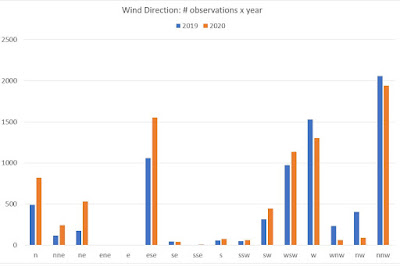On New Years Eve we were given a recommendation that "Native Trees and Shrubs of South- Eastern Australia" by Leon Costermans was a good reference to identifying the vegetation (especially the trees) in this area. Somewhat to our surprise we found we had a copy thereof! Indeed it seems to be very useful, especially as we have now pulled it out of the bookshelves. This has led to a thought that we should use this book, together with "Wildflowers of the Wilderness Coast" by Joy Grieg to document the plants along the various tracks on which we walk. Note that not all the plants have read Joy's book and thus my be shown under different habitats.
In difficult cases I have also referred to Flora of Victoria, but that is usually only helpful if you know more or less what you are interested in and are seeking confirmation (or more detail).
So we started this project, beginning at the beach end of the Chip track. This map, captured by eBird, shows our route, with the ends of the track marked by the arrows.
We made life difficult by starting this project in mid-Summer when few plants have flowers, but in most cases the leaves are quite distinctive. The images are in the order they were taken.
This was right on the beach. I think it is
Cakile maritima subsp. maritima, a species introduced from Europe known as Sea Rocket.Olearia axillaris: only leaves visible on this track.
The next day at Bastion Point we found a specimen in good flower.
The commonest wattle of the dune region Acacia longifolia.
This is a Tea-tree probably
Leptosperumum laevigatum.
Somewhere along the way I seem to have managed to delete a photo of
Leucopogon parviflorus which I know occurs throughout the path. I will try to add one later.
This next was, I thought, easy to identify as Pigface. Not so! That word isn't in Joy's book and the only Pigface in Flora of Victoria is an introduced species
Carpobrotus aequilaterus (Angled Pigface), which didn't seem to fit. Getting desperate I referred to
Plantnet which listed a few more species in the genus
Caropbrotus. Back to FoV and I came up with
Carpobrotus rossii which gets a mention in Joj's book (and FoV) with the vernacular name "Karkalla". That is certainly not a common name in most of society!
Joy also mentions, but no image, another species Disphyma crassifolium of similar appearnace but with round-section leaves. Some close perring will be needed as I am quite sure I have seem such a plant in the area.
Many of the
Banksias in the area were burnt but many are recovering. The most common species is
B. integrifolia (Coast Banksia) with entire leaf margins. Some of the leaves along this track looked quite 'toothed' but I cannot think of another species to attach to those trees.
The trees did flower in Spring but all the cones are now spent.
Both the creeper and the laminar plants in this image are in need of identification.
Senecio pinnatifolius was widespread all along the track. Some plants were still in flower ...
... while others had seedheads.
From the mid-way point of the track onwards we have found a good range of Spring orchids. The have obviously vanished by mid-January but to make this post more comprehensive I shall give some thought to gathering together the species found and their approximate location.
Although listed against "Heathland" rather than "Coastal Dunes" I believe this is
Amperea xiphoclada (Broom Spurge) a member of the Euphorbia family.
I have no idea of this blue job.
Pelargonium australeA sedge.
A little off the topic of this post but this image of a family of Hooded Plovers is interesting as it shows how the Plovers appear totally relaxed within about 30 metres of a horde of beachgoers. The situation might be different if unleashed dogs were present but as it was there is good news for the Hoodies. One expert who has seen this image commented that possibly the humans deterred other predators, such as the Magpie, exploring a pile of kelp 100m up the beach.























































